June 2021
We were up quite early on Saturday morning … a promise of hot and sunny weather was laying ahead of us and we were excited to see more of the Cederberg mountains.

With our coffee in hand, we wandered over to the beautiful horses of the owners of Rondegat.


The horses were not shy at all and came straight towards us when we approached them. We had plenty of opportunities to take some pictures and admire their beauty.


By now the sun was out and we enjoyed our breakfast and coffee on the front porch of the cottage – again, having a lovely view over the floodplain in front of us.
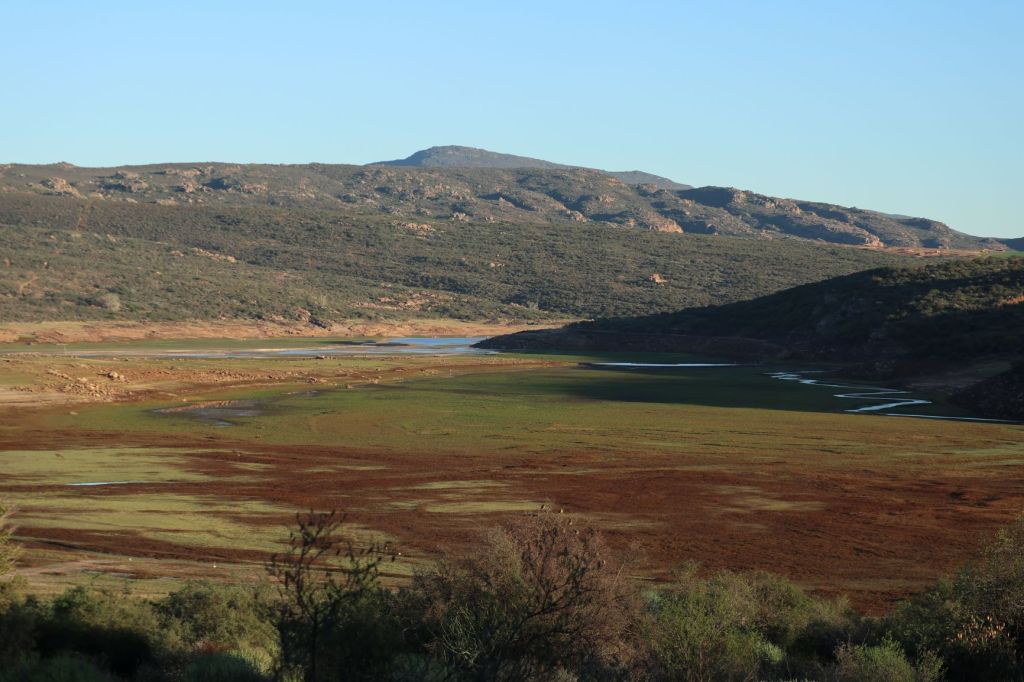
Dressed in shorts and t-shirts, we took our little picnic basket and got in the car to see more of the beauty of the Cederberg mountains. Our first stop was at the grave of a famous South African poet – C. Louis Leipoldt.
Grave of C. Louis Leipoldt

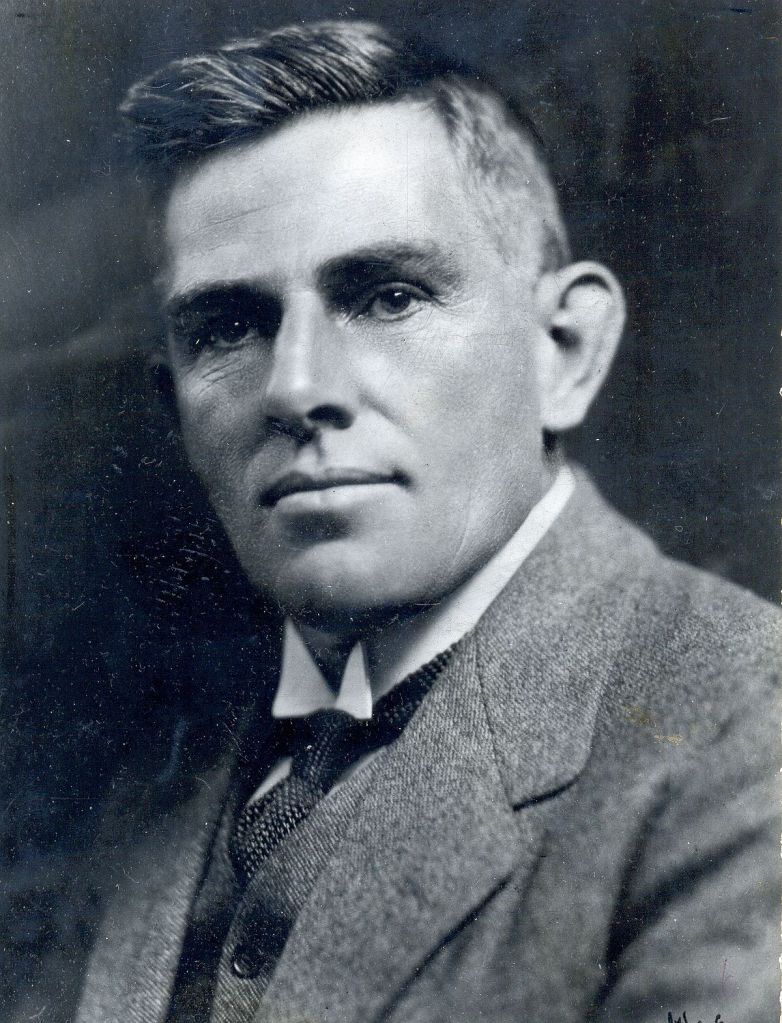
Christian Frederik Louis Leipoldt (normally referred to as C. Louis Leipoldt) was a very well-known South African poet, dramatist, medical doctor, reporter and food expert … that’s quite a CV! He was one of the leading figures in the poetry of the Second Afrikaans Movement.
During my high school years, we studied some of his poetry in my home language, Afrikaans. His father was a preacher of the Dutch Reformed Church in Clanwilliam and his grandfather the founder of Wupperthal (which we will also visit later in this post). Despite his chosen career as a doctor, he enjoyed spending time cooking and walking between the rock formations and plants of the Cederberg.

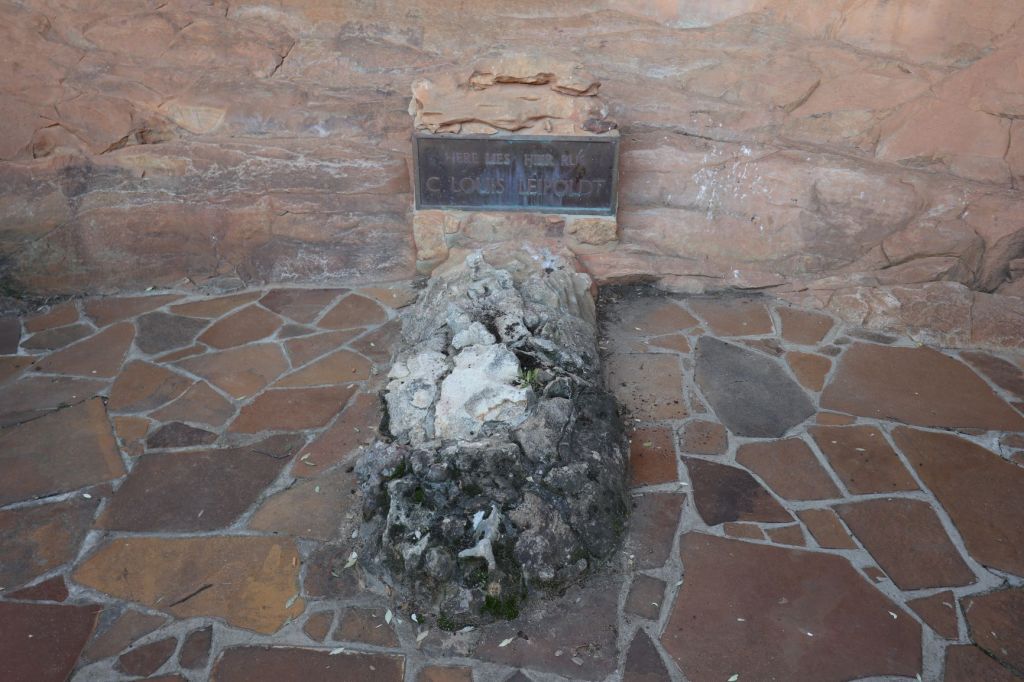
We were on the lookout for the famous rock formation of the ‘Soldaatkop’ (soldier’s head), but could not find it between all the magnificent rocks … we decided to try again on our return later that afternoon.
Traveller’s Rest:
After driving over the beautiful Pakhuis Pass, our next stop came in the form of a beautiful farm with a unique restaurant.

Traveller’s Rest is 34km from Clanwilliam and according to their website, the name originated from passing travellers who used to span out here next to the river to give water to their horses and oxen, as well as to rest before tackling the very steep Pakhuis Pass (the very same one we just driven).
Today, Traveller’s Rest is a beautiful place with a restaurant, gift shop and delightful self-catering cottages. This is the perfect place to stay if you would like to see some rock art paintings, as well as an array of indigenous plant species and birds.
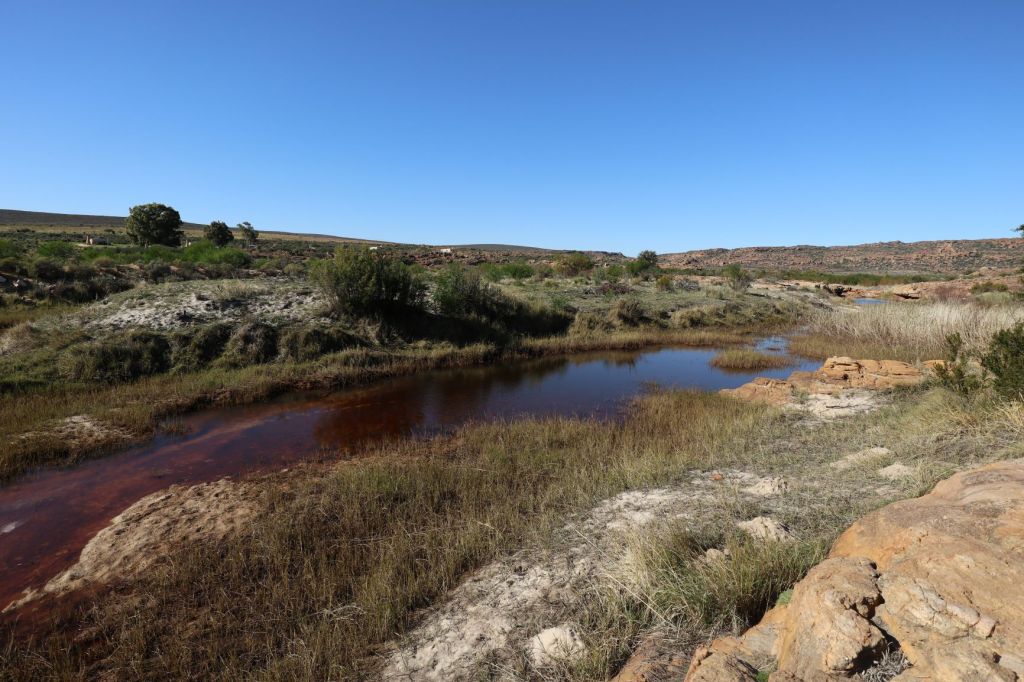
We took a stroll through the restaurant area – it is surrounded by so many different plants and we loved the little garden consisting of mostly aloe plants.

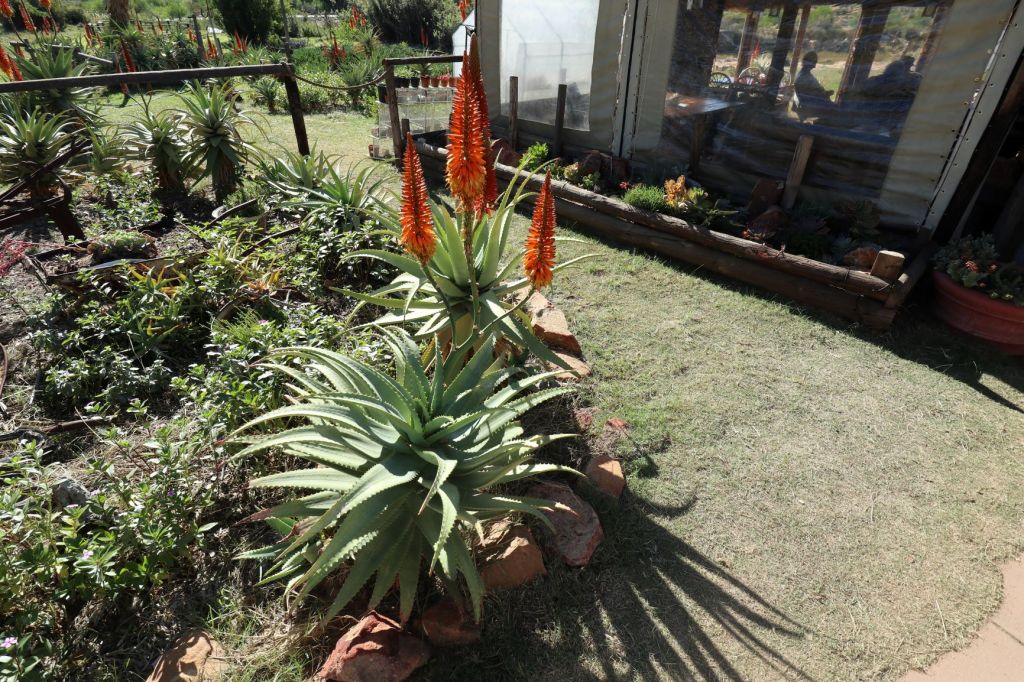
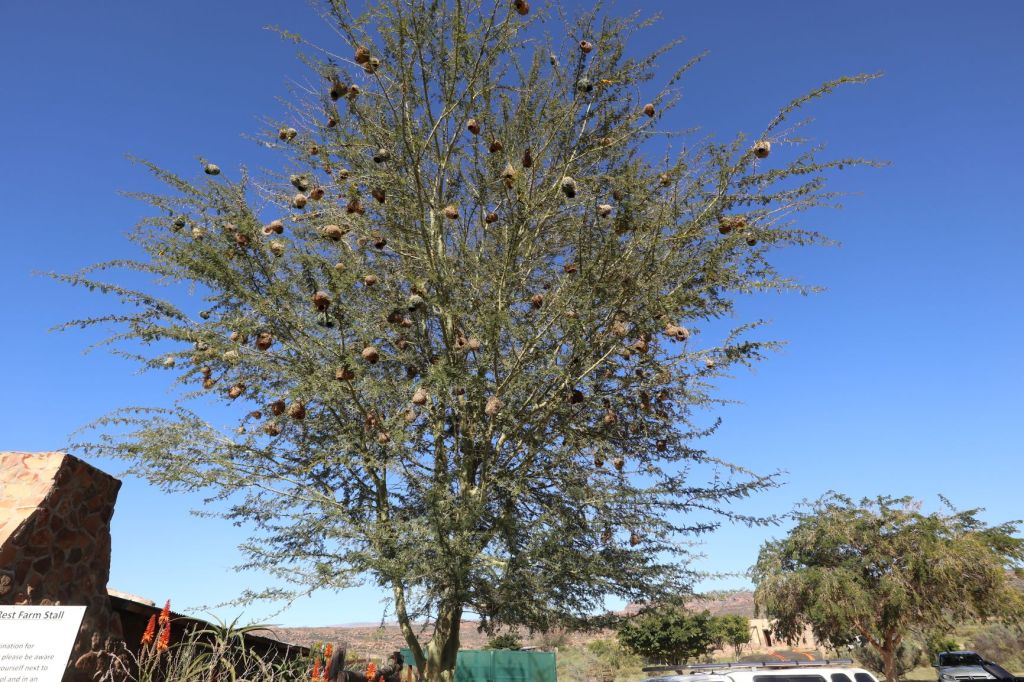
It was time to enjoy a cup of their very well-known Rooibos tea (meaning ‘red bush’). It grows in this area and the leaves are used to make a delicious (and healthy) herbal tea!

We read earlier in our favourite outdoor magazine (‘Weg’) that the owner of Traveller’s Rest walked the famous Camino (a pilgrimage in Spain) twice. As we also hiked the Camino twice (2017 & 2018), we were thrilled to see some Camino way markers on the walls of the restaurant. Unfortunately, the owner wasn’t there, but her daughter told us how much her mom loved her experience on the Camino … we can totally understand that!

After we enjoyed our Rooibos tea, I bought a box of the local Wild Rooibos tea to drink when we’re back home again (and to remember our wonderful time here in the Cederberg).

The small Moravian settlement of Wupperthal was now on our radar and the tarred road turned into gravel. On the way, were some stunning passes with amazing views into the valleys.

Wupperthal:
This beautiful little place has been a Moravian mission station since 1865 (although its origins are actually Rhenish). The name Wupperthal derives from the Wupper River in Germany, from where two Rhineland missionaries arrived in the Cape in 1829 to spread the Word among the indigenous people. These two missionaries were Theobald von Wurmb and Johan Gottlieb Leipoldt (the grandfather of C. Louis Leipoldt, who’s grave we’ve visited earlier).

On 30 December 2018 a devastating fire raged through Wupperthal and left almost 200 people homeless. Even some of the historic buildings were affected. This was of course a heavy blow for the town and its people, as some of them completely live from tourism.
After many meetings with different stakeholders, a restoration programme was started in March 2019. Since then, the following buildings were beautifully restored: The Church building and Parsonage, Creche (Educare Centre), Church Hall, Post Office, Mission Store and Mission House, Blacksmith Shop, Leipoldt House and Guest House.



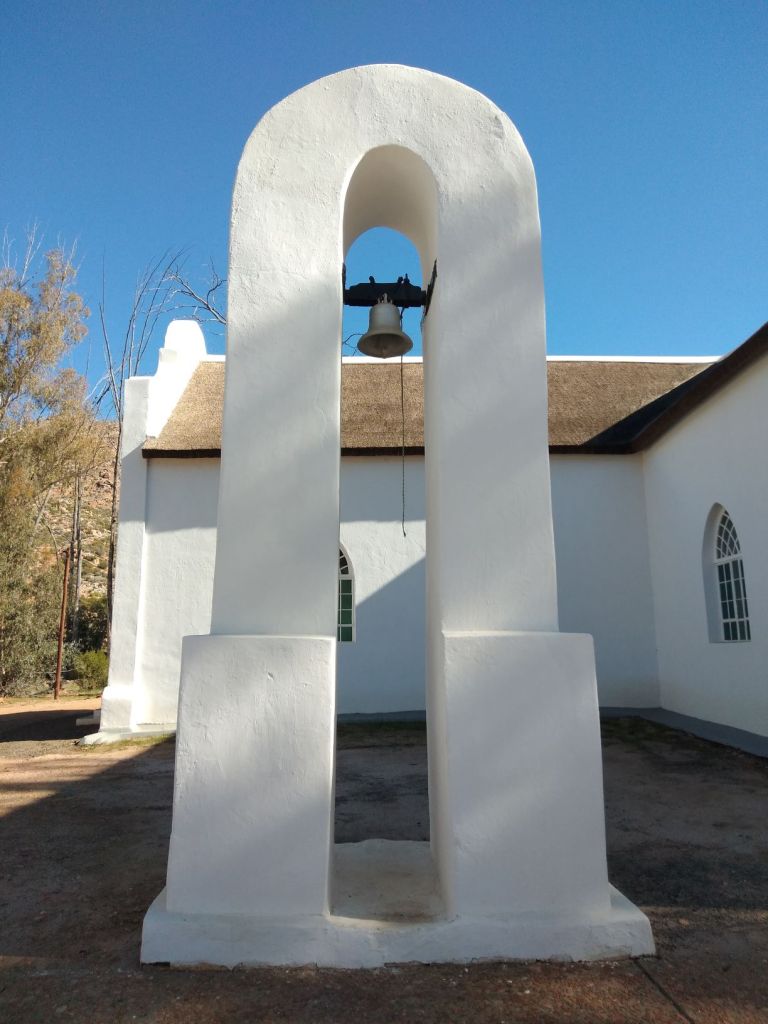

Unfortunately, families who were affected in this fire, are still housed in temporary homes which were built by the government. We trust they will soon be able to stay in their own (newly built) homes again, and although they received kind and generous donations, it will take some time to re-built all of the houses for these families.
It was now time to turn back to Rondegat, but first we needed to find that evasive Soldaatkop (‘soldier’s head’) rock formation.
Englishman’s Grave:
When we turned back on the tarred road, we saw a grave next to the road and stopped to have a look.

In the second Boer War, Lieutenant Graham Vinicombe Winchester Clowes was killed during a scouting mission in 1901. The Celtic cross was erected by his mother who travelled all the way from England.


We kept a close eye to the left side of the road, because we knew the Soldaatkop (‘soldier’s head’) must be somewhere between all these rock formations. At some point, we saw a hidden gravel road leading away from the main road and decided to take that … and then …
Soldaatkop (‘soldier’s head’):
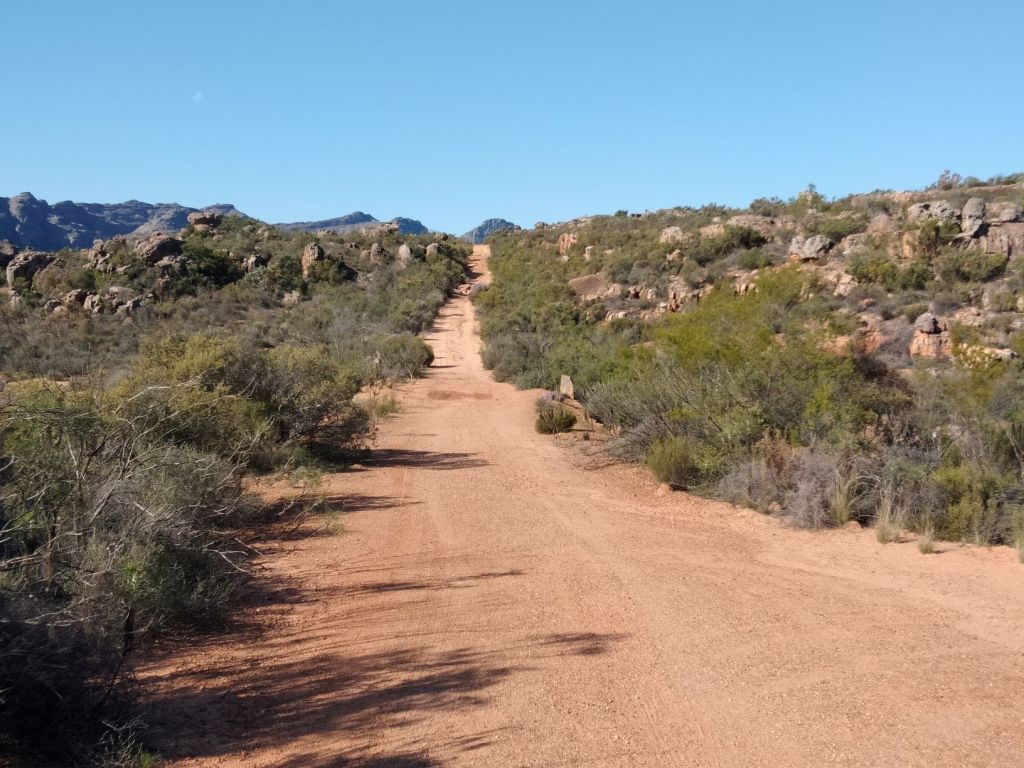



Some of our friends say the image reminds them a bit of Donald Trump … but as this was formed (and identified) long before Mr Trump’s time, I will stand by the name of Soldaatkop!
We spent some time here – walking between the beautiful rock formations and just enjoyed the smell and peaceful sounds of nature. It was also a good time to finish off the last sandwiches in our picnic basket before we returned back to our cottage.

Back at Rondegat, we made coffee and then took a few apples to give to the horses – I think they liked this little treat!

It was such a great day out in the Cederberg mountains. We enjoyed the incredible beauty of nature, chatting with the locals and seeing Wupperthal slowly but surely recovering to its former glory … and of course, finding the elusive Soldaatkop!
The only thing that was left for the day, was to witness another beautiful sunset and to get our fire started to enjoy an evening under the stars.


Tomorrow we will take a walk in the floodplain and enjoy the last day of our weekend.
Rondegat Weekend (Day 3) will follow here

I am so jealous of all the fun you guys have! I just love the photos & history you share, Corna. The tree with all the birds nests is like nothing I’ve seen! And, yeah, I wouldn’t curse the Soldier’s Head rock by referring to it as Donald Trump! Have a lovely weekend my friend! 🌞
LikeLiked by 1 person
Ah Lisa, the mountains are just so beautiful – we love exploring all these places! We do see these trees with birds’ nests in many places here in South Africa … but I’m always so excited to see one! Thanks, I also didn’t think the Soldier’s Head should change to ‘Donald’s Head’ (I will take your approval 😄). Have a great weekend too 💌.
LikeLiked by 1 person
The restored buildings in Wupperthal look beautiful and it’s so nice to learn about the place as I hadn’t come across it before. Marion
LikeLiked by 1 person
Thank you so much Marion. Yes, Wupperthal is such a lovely little village and I was really glad to see that they are busy restoring all those buildings. Have a nice weekend (and thanks for reading) 💌.
LikeLiked by 1 person
Such beautiful places, it fills me with peace just looking at these photos. The Soldier’s Head… once you mentioned some friends compared it to Trump, I couldn’t see anyone else, unfortunately..😅 Thank you for sharing, I’m learning so much about South Africa thanks to your posts 🙂
LikeLiked by 1 person
Nic, you’re so right about the peace that fills you in these mountains … that is my exact experience every time we walk or drive here ☺️. And yes, I’m afraid the appearance of the Soldier’s Head will never be the same 👀👀. I’m glad you’re enjoying our South Africa posts – thank you so much for reading and your lovely comments.
LikeLiked by 1 person
I think I have been hiking in the Cederberg mountains. A very special place.
LikeLiked by 1 person
Oh wow Mel, that’s great! Then you will know exactly why I’m so in love with these mountains 😍.
LikeLiked by 1 person
Yep – I get it!
LikeLiked by 1 person
The Cederberg mountains looks like such a scenic area. Ha, I can totally see the resemblance of Donald Trump in the soldier’s head rock formation! That gave me a good laugh. What better way to end the day than by watching the sunset by the campfire!
LikeLiked by 1 person
Ah, those mountains are just a huge favourite with us … but I’m afraid, the Soldier’s Head will never be the same for me again 😜. Isn’t that true … the best way of ending a day – around a fire while watching the sunset! Hmm, I can go back right now!! Thanks for reading (and enjoy your week ahead!)
LikeLiked by 1 person
What a beautiful place to stay, especially in the early morning light! And a lovely day out in the mountains too : I must say I can see the resemblance between the Soldaatkop and Donald Trump 😆
LikeLiked by 1 person
No Sarah … not you too!! ‘Soldaatkop’ will never be the same again 😅. It is such a beautiful farm where we’ve stayed – I would not mind going back there again! Thanks for reading and enjoy your Sunday.
LikeLiked by 1 person
This is lovely and so interesting. I got some Rooibos tea and didn’t care for it although I like most herb teas. I am sure if I had the right kind I would! Love the horses, of course, and all the history. And yes, I thought the head was a bit Trumpish even before I read your remarks! Thanks for your post.
LikeLiked by 1 person
You know, I grew up with Rooibos tea (my mom gave that to me when I was still a baby) and to this day I love to have a cup before I go to bed. There are so many variaties of Rooibos, but I like the plain (wild) Rooibos tea – I taste nature in it (or maybe it’s just my imagination 😁). Oh, I hope the Cederberg Wilderness committee is not reading our blog … they will probably feel obliged to change the name of the ‘Soldier’s head’ 😜.
Thanks for reading and your lovely comments. Corna
LikeLike
It’s so beautiful. We drove through the area when I was about 12, and stopped at Traveller’s Rest ourselves so thank you for bringing the memories back. And oh my goodness, I can’t stop laughing – it’s SO Trump!!!!! 🙂
LikeLiked by 1 person
Ah Hannah, I’m so glad you have beautiful memories of your trip through the Cederberg mountains … it’s such a magical place for me! My goodness, I will have to go back to the ‘Soldaatkop’ and make a few ‘adjustments’ to that rock formation 😄.
LikeLiked by 1 person
Have enjoyed the next leg of your adventure. The Trump rock was a real hoot and ohhh those horses. Just gorgeous.
LikeLiked by 1 person
Thanks Leighton. Oh, that rock … it is now difficult for me to look at it as the ‘Soldier’s Head’ after all the comments 😉. This was indeed a great day out in the mountains! Best for the week ahead.
LikeLiked by 1 person
Your photos bring out the beauty of this rugged country. I’ve never seen so many bird nests in one tree.
LikeLiked by 1 person
Thanks a lot – much appreciated! I think I’ve mentioned somewhere in the comments to see that many bird nests in a tree is quite common here in South Africa, but I never get tired of it 😊.
LikeLike
I’ve just finished sipping on one of my many cup of rooibos tea’s I’ll have for the day (guilt free) I drink it black and with no sugar and I thoroughly enjoyed reading your post. Thank you for sharing such lovely images and historical information, so much appreciated. Stay safe and take care ❤
LikeLiked by 1 person
Ahh, it’s great to hear you’re also a fan of Rooibos tea … I must admit, I do add some milk in mine (no sugar) … but the best way, is to drink it like you do! Thanks for reading about our day in the mountains, I’m glad you’ve enjoyed it. Take care 💌.
LikeLiked by 1 person
I always find it nice when we can mix a bit of history into our travels!
LikeLiked by 1 person
Absolutely … it’s a bit like “learning something new, while enjoying yourself” 😁. Thanks for popping in 👍🏻.
LikeLiked by 1 person
Such an amazing place! My favorite picture is of the church. So much history, What a shame about the fire.
LikeLiked by 1 person
You’re absolutely right Diane, the Cederberg is indeed an amazing place! I love that church building too – they’ve restored it so beautifully. Thank you for reading and enjoy the rest of your week. Corna
LikeLiked by 1 person
Another brilliant post, Corna and I am learning so much, even a bit of Afrikaans ( a language I know nothing of ). I had worked out Soldaatkop when I read it as I knew kop(f) is Dutch / German for head so it was pretty obvious. You’ll be glad to know I don’t see “the Donald” in the Soldaatkop rock but I am wondering why it is called that. Obviously, the area featured in the War (whatever you wish to call it) as the beautifully tended grave of the British officer nearby attests. Obviously someone still cares for it, which is very decent. Was this area the sight of a major battle or heavy skirmishing (which the Boers were so good at)?
Isn’t it odd that if we had all been born maybe 150 years ago, Berto and I could potentially have been shooting at each other and you might well have been incarcerated in one of those hideous concentration camps? People like to forget that it was the British that invented them, Hitler just borrowed the idea! Here we are now, the best of friends and it amazes me, as it always does, how quickly the world turns.
I do not like horses on the principle they are dangerous at both ends. One end bites you and the other end kicks you but these are magnificent creatures. I’ll bet they enjoyed the treat as I don’t see any apple trees in their paddock for them to have windfalls off.
Like you, I love roobios tea although it is not so easy to get where I live, but I know it is massively popular in continental Europe and I often bring back a box or two of bags when I was still able to travel. I distinctly remember bringing some back from Madrid a few years ago.
I am eagerly awaiting the next instalment now, which I know is there, it is just a matter of me getting there
LikeLiked by 1 person
Thanks Fergy for reading about our Rondegat weekend (and I’m sorry you are still struggling to sleep … maybe that’s a thing when you start getting older, because I’ve never had a problem sleeping – just put my head on the pillow and gone till the next morning – but these days I’m wide awake for an hour or two during the early morning hours 🙄).
After reading your comment here, I’m glad we did not live 150 years ago … that incarceration sounds a bit daunting to me! Yes, how amazing is it that times have changed so significantly over just a couple of years. This area is known as a popular spot where the Anglo Boer War (late 1800’s till 1902) has taken place, so I’m not surprised to have found the Englishman’s grave there. And that’s probably also why that rock formation got the name as ‘Soldaatkop’ (well done, on recognising the Afrikaans name).
Hey, and you know what … I’ve also had some rooibos tea in Madrid! I was so surprised to find it there! They say it’s a good remedy to take before you sleep … 😴.
LikeLiked by 1 person
Hi again, Corna,
don’t worry about the sleep thing, I have had it for years and it does not bother me any more, especially now I am retired. I usually manage a few hours in the afternoon and that does me nicely. I think it was all the years in the Forces where we worked at night all the time that did it. I’ll swear I barely saw daylight for about five years!
As for the Afrikaans, I hardly speak a word or German or Dutch and looking at your comments here with your Afrikaaner friends I cannot understand a word of it. I can pick out the odd noun by piecing together the littleof the afore-mentioned languages but the grammer and verbs are a mystery to me. I just like doing things like that, trying to solve riddles and Soldaakop was pretty easy. I am also guessing that the Brandewyn River (sorry if I have spelled that wrongly) means Brandywine River in English, although why it would be called that is a mystery to me.
Yes, it is true although not ever spoken about by the British, that you would probably have been in what is effectively a concentration camp. I am very proud of my country, fought for it and buried friends for it but it is not a part of our history I am particularly proud of. What amazes me even more is that after the Boer War, a mere 12 years later, the South Africans were sending guys to France to fight for the British Empire, over a quarter of a million of them. The same thing happened shortly after in the Second World War when over 11,000 of them died. This was people fighting for a country that half the nation had been f
igting against less than 40 years previously.History can really play with your head if you let it.
All I know now is that we are friends and I hope it remains so.
Roobios tea is really big in Eastern Europe, you’ll get it in cafes in Poland, Slovakia, Slovenia, Czech Republic, everhwhere. I have not had any for ages, I must go and hunt it out!
LikeLiked by 1 person
You’re not doing too bad with the translation from Afrikaans to English! Brandewyn River would be called the ‘Brandy River’ in English … and why is it called that? No idea – maybe the travellers of years ago rested here next to the river with a good old self-brewed brandy 😁.
Like you’ve said, wars are complicated … sometimes soldiers are together in one fight and then again enemies in a later fight … really confusing! But hey, at least we can still be friends after all of these unpleasant fighting!
Yes, I know our rooibos tea are exported to many countries around the world … hope you get hold of rooibos tea – otherwise I will have to put a couple of boxes in the post for your 😀.
LikeLiked by 1 person
Thanks for your kind offer of the tea, Corna but I think that food parcels from SA will be unnecessary just yet. I just need to look round a few more supermarkets, I know I have seen rooibos tea somewhere.
Thanks so much for your compliment on my appalling attempts to understand Afrikaans although, as I said, much of understanding a foreign language is merely common sense. You look at a word, which in European probably comes from Latin and you work it out, at least closely, Brandiwyn was easy.
As for war, well, that is a little more difficult to understand. I know Berto served obviously but I would never ask him what he had done, it is a sort of unwritten rule amongst people like us, you don’t ask unless someone else volunteers the information. I don’t know if he has seen active service or not.
I know you have been husband and wife for a long time but I wouldn’t even ask if you and he had discussed what he did when he was in uniform or even out of it, as some of us were.
The one thing I do know is that war is uiterste kak yes, I looked it up to avoid any confusion). Ask him and see if he agrees or not. War is being uncomfortable most of the time, being cold, wet and miserable. War is being afraid and anyone who say otherwise is either a fool or a liar and I have no time for either. War is being utterly terrified, it is surviving, that is all, and then burying your friends who weren’t so lucky. Believe me, war is uiterste kak.
Sorry to be so heavy, I really don’t want to bring you down. I am fine and quite happy now so I think I’ll have another Strongbow (much better than Woodpecker!) and get back to some more writing about Broadstairs!
LikeLiked by 1 person
I also like Strongbow more than Woodpecker … and about a year ago, our liquor stores started to sell Strongbow (I was a happy chappy)!
Yes, we use the word ‘kak’ most when things are not the way we like it … you’ve certainly made your point! Both Berto and my brother (now living in the UK) served in active military. While Berto served in one of our biggest black townships here in South Africa, my brother went to a neighbouring country to be in active service there … and like you’ve said, they are not really talking about it (which is quite alright with me).
I’ve just read your 2nd edition of Broadstairs – loved it!
LikeLiked by 1 person
Yes, Strongbow is getting a much more global profile now. Why? Because they have been owned for years by the almighty Heineken who are now, I think the second largest brewers in the world after Anhauser-Busch (Budweiser, Coors etc.). I could get it anywhere in Canada, I was a very happy chappy and so was Lynne who drinks it as well!
I am not surprised Berto and your brother don’t talk about things, that is just the way it is and it probably works despite what silly little 23 year old head doctors would try to tell you. That is why I refuse to see one.
I can guess where your brother served, I met a few “blades” from RSA when I was in, good guys, hard men. You say it is alright with you them not talking and that is exactly the right attitude.
Where does your brother live in UK. I am not looking for an address obviously, just a county or city would be fine!
LikeLiked by 1 person
My brother and his family lives on the outskirts of Bradford. His wife is from South Africa as well (and one of their children was born here, while the boy was born in the UK). It’s a long way to be apart from family … but we try to stay in touch as much we can.
LikeLiked by 1 person
I’m sure you do.
Bradord, that’s “Oop North” as we say here, Yorkshire. I love Yorkshire. If you want to see it at it’s best you should get a narrowboat and get on the canals. I know that is something you don’t have in SA. Have a look here. It starts here if you are really bored but gets onto the boating bit a little further on. In the meantime , where your brother lives is not too far from where I was writing about in this series of posts.
If you want something visual, have a look here. OK, it takes a day or two to get on the boat but it is a good idea of the lovely part of Britain your brother lives in. I love it.
Right, I know there is only one hours time difference between us (not sure about our BST (summer time) but it is time for the old man’s afternoon nap here, even if it has been long-delayed with sorting out all my blog comments. I’ll swear I never thought anyone would even read it, it was meant more or less as my epitaph that what is left of my family could read after I had gone and share some of the wonderful places I have seen in my life and probably will never see again. I get lovely comments from all over the world and it actually scrambles whatever of my brain is left after the alcohol has done it’s business.
Thanks so much for being a friend, really it means more than you will ever know.
Speak soon,
Fergy.
LikeLiked by 1 person
We’ve always talked about a trip on a canal (you’re right, not something we have here) … maybe a good option when we (eventually) get the opportunity to visit my brother and his family!
Hope that afternoon nap was great! It’s now a day later and I’m ready to have a quick bite to eat and then maybe a bit of reading (which mean I will probably fall asleep ☺️).
Take care – we’ll see you again somewhere in the blogging world … and great to have you as a friend as well!
LikeLiked by 1 person
A canal boat is a great option for many reasons. Firsstly, you are limited to 4 mph as this is the national speed limit on British canals so you have no option but to relax, you are not going to be able to race somewhere.
Secondly, you get to see things from a totally different perspective. You can be in the middle of an industrial town but seeing it from a completely different angle, seeing all the old industrial architecture etc. Thirdly, the people you meet on “the Cut” (that is what the canal gets called in UK) are brilliant, you will never meet friendlier people.
You really should think of it when you can travel again.
LikeLiked by 1 person
Some excellent reasons to think about that canal trip … going nowhere slowly (our motto)!! Thanks Fergy 🌸.
LikeLiked by 1 person
Going nowhere slowly is exactly narrowboat mentality, that is what it is all about. Honestly, it would be ideal for you. Have a look here
or here
Hope you enjoy it and do really think about a narrowboat trip, it is just so magical, I know you won’t regret it.
LikeLiked by 1 person